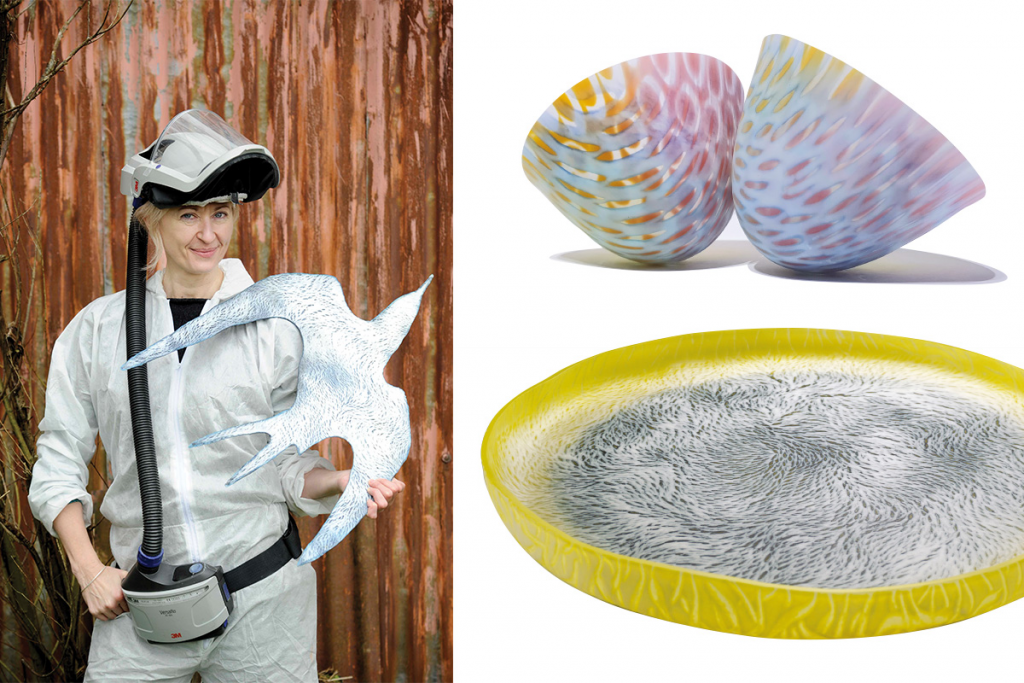Amanda Simmons Glass Artist

Interview Catherine Coyle
“Scotland has been my home for more than 15 years now. I love this land and its people. It has provided me with many opportunities to get on with my career, with an extremely well-supported craft sector and a deeply knowledgeable public. Making is very much still embedded in the psyche here in Scotland, which has given me a lot of insight into the whys of making. Dumfries & Galloway is full of creatives. Moving here allowed me to escape city life but still be linked to great cities and be part of the region’s booming craft sector. It means I’m able to have a workshop at home, so no commuting time or costs, and it gives me space to work on my glass designs and build a business with a great deal of support available.
I grew up in Kent and my practical/design skills have come from my parents – my mum making exquisite, many-tiered wedding cakes, and my dad being able to make anything or think through any technical problem. I left school at 16 to do an engineering apprenticeship with BT. I’ve always enjoyed taking things apart and fixing them, but electronics wasn’t for me. Instead, after a degree in pharmacology and toxicology, I became a clinical perfusionist (running the heart-lung machine for cardiac operations), working in hospitals for eight years in and around London.
At 30, I made another radical career change. It all happened very quickly after a week’s intensive stained-glass course. I’d always wanted to be an artist but up until that point I hadn’t found my medium. I started studying kiln-formed glass at Westminster College and then followed this up with a postgraduate certificate in glass & architecture at Central St Martins. It has turned out to be the longest-running career I’ve had, perhaps because there is no such thing as a typical day in this job!
My work is made in response to exhibitions or gallery requests, so I do have many days preparing ideas and samples, reading and carrying out research. I’ve been developing an international practice over the last seven years, so I’ve had the chance to travel a lot and experience other glass centres around the world, teaching and taking up residencies. The latter have been incredible – I’ve had four great artist residencies in the past nine years. These intense periods of working have often supplied me with enough material for several years’ worth of work. Through Lyth Arts Centre in Caithness, for instance, I worked with scientists at the Environmental Research Institute in Thurso looking at the regeneration of the Flow Country and the risks to seabirds in the Pentland Firth from turbines on the sea bed. More recently, my work has been inspired by my travels across Australia. The body of work Southern Hemispheres is a celebration of seeing the world from another perspective and how the light from a different angle changes what we see.
I work most days, since I love what I do. It is so varied, but I do make time throughout the week to get out into the lush countryside when it isn’t raining. I cycle, run and paddleboard across the region, soaking up inspiration as I go.
I spent time during lockdown developing online teaching courses via Zoom. Teaching has actually been an unexpected bonus of this career. I started with six-year-olds at craft club at Gracefield Arts Centre in Dumfries, and now I travel to America and Australia teaching my specific glass techniques. My glass manufacturer produced a video showing one of the ways I work with glass. It has turned out to be a great source of income during the past couple of years and has enabled me to make exactly what I want.
I don’t accept many commissions but one I’ve been working on lately has been very rewarding; it’s become more like a patronage. The client was given a retirement present of some commissioned art and she chose me. She came to see my work and studio to get an under-standing of my techniques. I showed her some work in progress – I was trying to develop super-lightweight glass birds. It’s not a very commercial idea as they’re so fragile. She was taken with the birds and we’ve had a dialogue since on the progression of these ideas. When it’s safe to do so, a flock of small birds will appear on her wall.”





